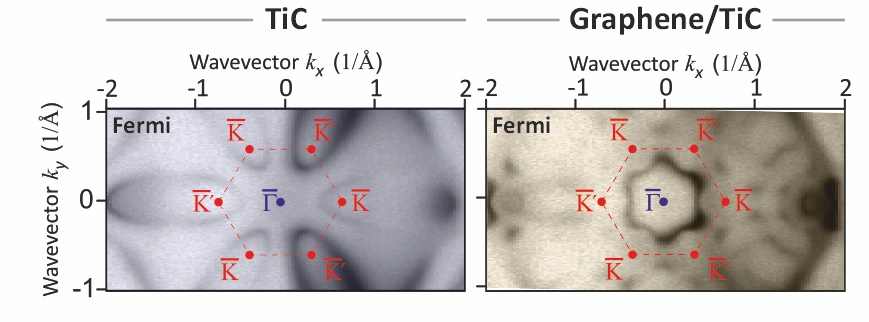Graphene on titanium carbide triggers a novel phase transition
HZB team discovers a way for controlling and manipulating the electronic properties of materials by coating them with graphene
Researchers have discovered a Lifshitz-transition in TiC, driven by a graphene overlayer, at the photon source BESSY II. Their study sheds light on the exciting potential of 2D materials such as graphene and the effects they can have on neighboring materials through proximity interactions.
Stacking 2D materials has garnered a lot of attention in recent years as it provides a unique opportunity to tailor material properties in a highly controllable manner. However, the influence of 2D materials on the properties of neighboring materials through proximity effects is not yet fully understood. In particular, very sensitive properties such as band gaps in semiconductors and excitonic properties have been observed to be influenced. Fermi surfaces of bulk metals have so far not been among the properties sensitive to a proximity effect.
The Fermi surface of a metal is a mathematical concept to represent the electrons of the highest energy in the material. Only these electrons participate in properties such as electrical conductivity. An important aspect of the Fermi surface is that it represents them in terms of the direction of their movement.
The new study by Andrei Varykhalov and his colleagues at BESSY II shows that a graphene layer can induce a Lifshitz transition in the near-surface region of an underlying metal, TiC: The Fermi surface transforms from a hole-like to an electron-like Fermi surface. The reported change in Fermi surface character is particularly relevant since it changes the orientation of the movement of the electrons and in the presence of a magnetic field it changes the orientation of the macroscopic electric current.
The present finding is an exciting development as it provides a new avenue for controlling and manipulating the electronic properties of materials, which has implications for a range of technological applications, for example designing materials with quantum properties such as high temperature superconductivity.
Publication:
Phys. Rev. Research (2023): Lifshitz transition in titanium carbide driven by a graphene overlayer
M. Krivenkov, D. Marchenko, E. Golias, M. Sajedi, A. S. Frolov, J.Sanchez-Barriga, A. Fedorov, L. V. Yashina, O. Rader and A. Varykhalov
DOI: 10.1103/PhysRevResearch.5.023120
Contact:
Helmholtz-Zentrum Berlin für Materialien und Energie
Department Spin and Topology in Quantum Materials
Dr. Maxim Krivenkov
Phone +49 30 8062-12345
Email maxim.krivenkov(at)helmholtz-berlin.de
Dr. Dmitry Marchenko
Email dmitry.marchenko(at)helmholtz-berlin.de
Dr. Andrei Varykhalov
Head of Group “Photoelectron Spectroscopy and Scanning Tunneling Microscopy”
Phone +49 30 8062-14888
Email andrei.varykhalov(at)helmholtz-berlin.de
Press release HZB, 25 May 2023
